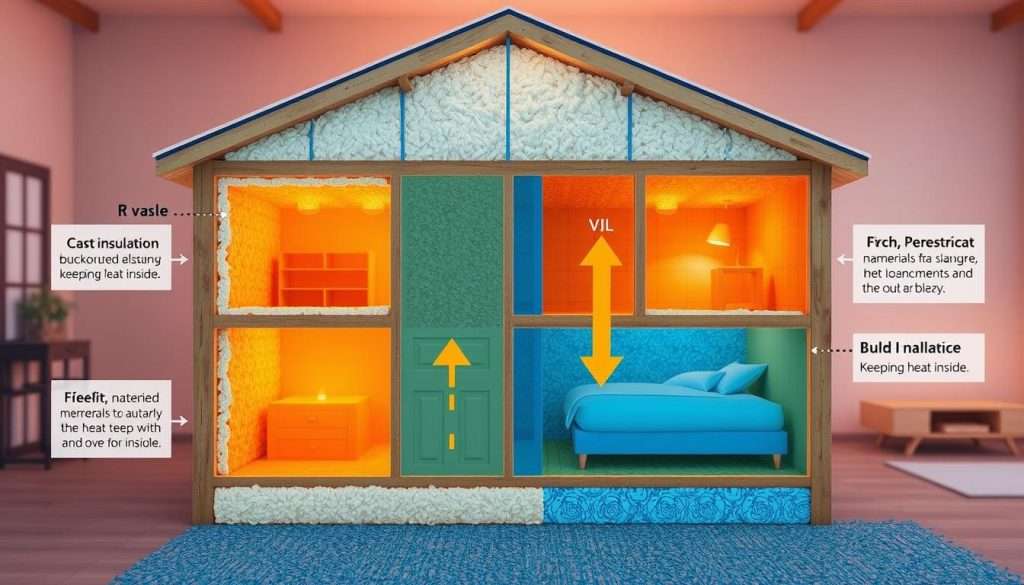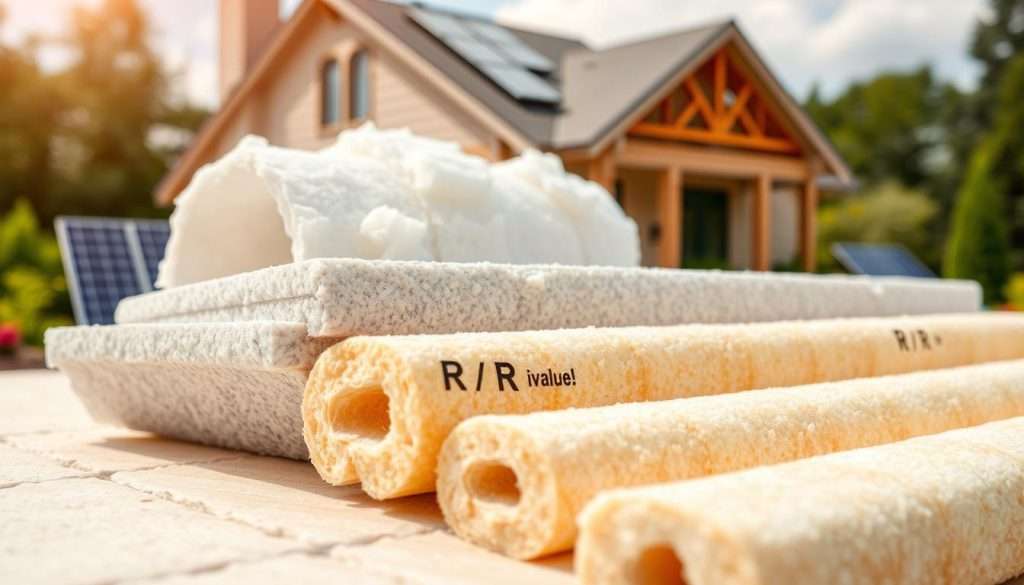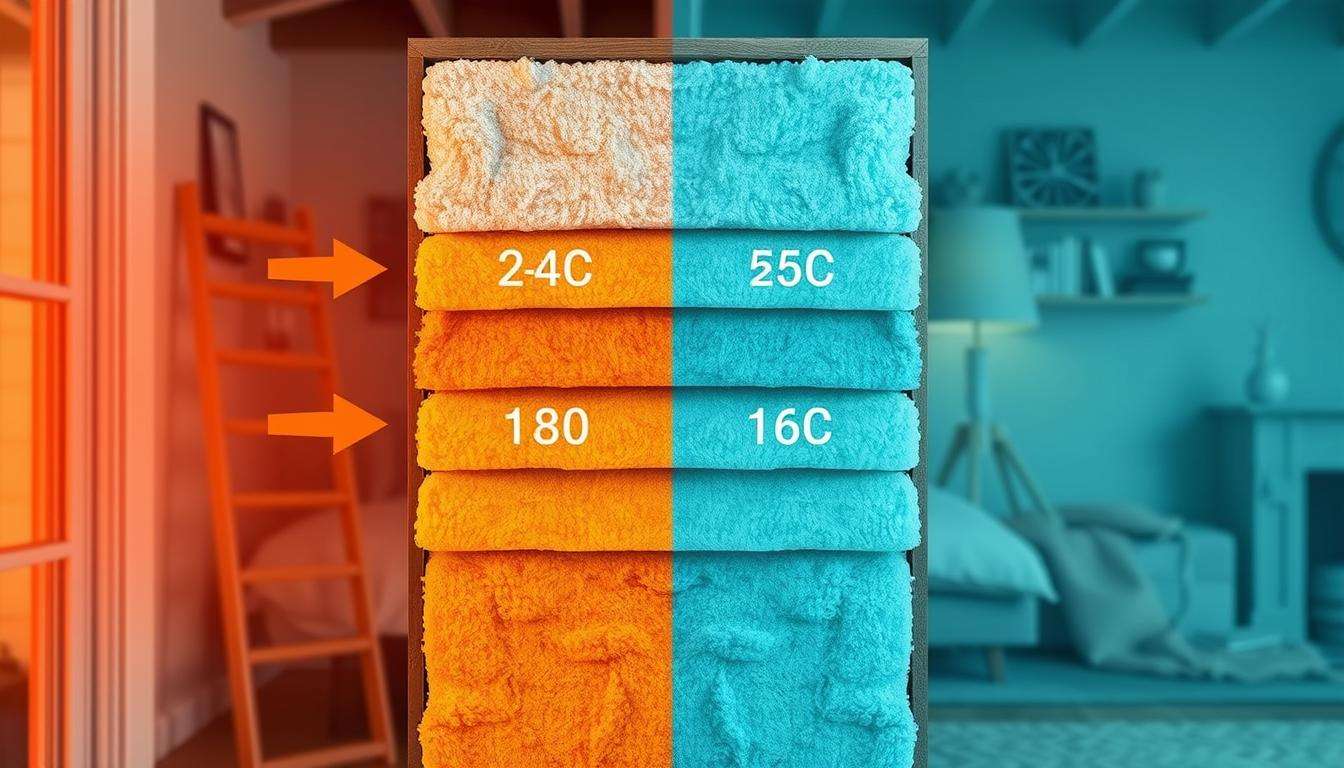Knowing about R value in insulation is key for homeowners and DIY fans. It shows how well insulation stops heat from moving. The higher the R value, the better it keeps your home warm and saves energy.
This guide will show why R value matters in different insulation materials. It’s important for keeping your home comfy and saving on energy bills.
Key Takeaways
- R-value measures the thermal resistance of insulation materials.
- A higher R-value indicates better insulation efficiency.
- Proper insulation helps maintain comfortable indoor temperatures.
- R-value significantly impacts energy consumption and utility costs.
- Choosing the right R-value is essential for effective home insulation.
Understanding the R Value: Definition and Importance
To understand insulation in our homes, we need to know what R-value means. It shows how well insulation stops heat from moving. This is key for keeping our homes warm or cool.
A higher R-value means better insulation. This means we use less energy to stay comfortable inside.
What Does R Value Measure?
The R-value shows how well insulation stops heat. It helps us pick the best insulation for our homes. This keeps our homes warm in winter and cool in summer.
Remember, higher R-value means better energy saving. This is important when choosing insulation.
Why Is R Value Crucial for Home Energy Efficiency?
R-value is very important for keeping our homes energy efficient. Good insulation lowers heating and cooling costs. It makes our homes more comfortable and saves money on energy bills.
Choosing the right R-value for your area makes your home more energy efficient. This is how we make our homes energy-saving havens.
R Value and Insulation Types
Learning about insulation materials can make your home warmer and more energy-efficient. By looking at R-values, you can choose the best insulation for your needs. This includes how well it works, its cost, and how easy it is to install.
R Values for Different Insulation Materials
The R-value shows how well insulation stops heat from moving. Here are some common insulation types and their R-values:
| Insulation Material | R-Value per Inch |
|---|---|
| Fiberglass | 2.9 – 4.3 |
| Foam | 5 – 6.5 |
| Cellulose | 3.2 – 3.8 |
Comparing Fiberglass, Foam, and Cellulose Insulation
When you compare these insulations, think about a few things:
- Effectiveness: Foam is the best at keeping heat out, with a higher R-value than fiberglass and cellulose.
- Cost: Fiberglass is the cheapest. Cellulose is a bit pricier but still works well.
- Installation process: Fiberglass is easy for DIY projects. Foam needs a pro because it expands a lot.
Evaluating R Value in Home Construction
When you build or fix up your home, checking R-value is key. It helps make sure your insulation works well. You need to know how to figure out R-values for places like attics, walls, and floors. This way, you can pick the right insulation materials for each spot.
Knowing where to put your focus will help a lot. It makes your home keep heat better.
Calculating R Value for Specific Areas
To find the R-value in your home’s different parts, follow these steps:
- Attics: Measure how thick the insulation is. Then, multiply that by the R-value of the material per inch.
- Walls: Think about the inside and outside finishes. Also, what kind of insulation you’re using.
- Floors: Don’t forget about crawl spaces or basements. They might need special insulation.
Factors Affecting R Value in Homes
Many things can change your home’s R-value:
- Installation Quality: Good installation means better insulation. Bad installation means it won’t work as well.
- Moisture: Wet insulation doesn’t work well. Make sure you manage moisture.
- Age of Insulation: Insulation gets worse over time. It can settle or break down.

By fixing these issues, you can keep your insulation working great. This makes sure your insulation materials do their job well.
| Area | Recommended R-Value | Common Insulation Materials |
|---|---|---|
| Attics | 30-60 | Fiberglass, Spray Foam |
| Walls | 13-20 | Cellulose, Foam Boards |
| Floors | 19-25 | Fiberglass, Rigid Foam |
How to Choose the Right R Value for Your Home
Choosing the right R-value for your home is key to good insulation. Your location and climate play big roles. Knowing these helps your home use energy well.
Recommended R Value Levels for Various Climates
Different places need different R-values for comfort. Here are some tips:
| Climate Zone | Recommended R Value for Walls | Recommended R Value for Attics |
|---|---|---|
| Cold (Zone 5 and above) | R-20 to R-30 | R-49 to R-60 |
| Moderate (Zone 3-4) | R-13 to R-19 | R-38 to R-49 |
| Warm (Zone 2) | R-13 | R-30 to R-38 |
Use your local climate to guide your choice. For more help, look at insulation R-value resources.
Balancing R Value with Cost and Availability
Higher R-values mean better insulation but cost more. Think about these points:
- Material Type: Fiberglass is cheaper than spray foam but less effective.
- Budget: Decide how much you can spend on insulation without hurting your wallet.
- Availability: Make sure the insulation you want is easy to find.
Finding the right mix of cost and performance helps you save money. This way, you get good insulation without breaking the bank.
R Value Testing and Standards
Knowing how R-value is measured helps you choose the right insulation. The American Society for Testing and Materials (ASTM) sets standards. These standards make sure insulation ratings are real.
They help you trust the insulation thermal resistance values. This makes choosing and installing insulation easier.
Understanding ASTM Standards for R Value
ASTM has many standards for testing insulation materials. These standards tell manufacturers how to test insulation. This way, results are always the same and accurate.
Some common ASTM standards include:
- ASTM C518: This standard uses a heat flow meter to test insulation.
- ASTM C177: It checks insulation with guarded hot plate methods. This is key for accurate ratings.
- ASTM C578: This standard is for rigid cellular polystyrene insulation. It guides testing in different conditions.
How Manufacturers Determine R Value Ratings
Manufacturers figure out insulation ratings from ASTM tests. They do this by:
- Testing in controlled environments with standard methods.
- Figuring out R-values from material thickness, density, and thermal properties.
- Keeping up with new standards and insulation tech.
This leads to trustworthy insulation ratings. Knowing how these ratings are made helps you choose better for your home’s energy.
| ASTM Standard | Description |
|---|---|
| ASTM C518 | Measures thermal properties using a heat flow meter. |
| ASTM C177 | Evaluates thermal performance with guarded hot plate methods. |
| ASTM C578 | Focuses on rigid cellular polystyrene insulation. |
Common Misconceptions About R Value
Knowing what R value means in insulation is key for smart home choices. Many myths confuse people about insulation’s effectiveness. We’ll clear up these misconceptions for you.
R Value vs. Insulation Thickness
Many think thicker insulation means a higher R value. But, the type of insulation matters too. For example:
- Fiberglass insulation’s R value changes with its density and thickness.
- Foam boards can have high R values even when thin.
- Cellulose insulation needs more thickness to match other materials’ R values.
This shows R value isn’t just about how thick insulation is. Knowing each insulation type’s special features is crucial for better home insulation.
Debunking Myths about High R Values
Some think the highest R value is always best. But, this can be costly and impractical. The right R value depends on:
- Your home’s location and climate.
- The areas of your home needing insulation.
- Your budget for insulation materials and installation.
Choosing the right R value is about finding a balance. It’s about getting good insulation without overspending. Always think about your home’s unique needs when picking an R value.
Improving Your Home’s R Value
Boosting your home’s R Value makes it more energy efficient and cozy. Try these DIY tips and professional services to keep your home warm all year.
DIY Tips to Enhance Insulation Performance
Ready to get your hands dirty? Here are some easy steps:
- Seal air leaks: Find where cold air gets in, like around windows and doors. Use caulk or weatherstripping to stop it.
- Add insulation in key areas: Look at your attic, basement, and crawl spaces. Adding fiberglass batts or spray foam works well here.
- Use insulating curtains: These help keep heat in by blocking it through windows.
- Install radiant barriers: In attics, these barriers reflect heat away. This can save on cooling costs, especially in warm places.
Professional Solutions for Increasing R Value
Need help from experts? Here are some professional options:
- Blown-in insulation: This fills gaps in your insulation without tearing down walls.
- Spray foam insulation: It creates a tight seal and boosts R Value. But, it’s best left to the pros.
- Reflective insulation systems: These are perfect for sunny areas. They help lower energy costs by keeping heat out.
- Insulation retrofitting: Experts can check your home and suggest the best ways to improve R Value.
Whether you do it yourself or get a pro, boosting your home’s R Value saves energy and makes it cozier.
R Value and Energy Savings
Homeowners want to save money on energy bills. Knowing about R-value helps you choose the right insulation. More insulation means less energy use, which lowers your bills.
Good insulation makes your home cozy and saves money. It’s a smart choice for your wallet and comfort.
How R Value Affects Utility Bills
Your insulation’s R-value affects your bills. Higher R-values mean better heat control. This means your home stays warm or cool longer.
Here’s how R-value helps:
- Less energy loss in winter and summer.
- Heating and cooling systems work less.
- Indoor comfort improves, so you can adjust the temperature.
Real-life Examples of R Value Impact
Many homeowners have saved money by improving their insulation. Here are some examples:
- A family in a cold area raised their attic insulation. They saved 30% on heating costs.
- An eco-friendly homeowner upgraded wall insulation. They saved 20% on cooling costs.
- Advanced insulation in a home raised its R-value to R-40. This saved $500 a year on bills.
Improving your insulation’s R-value can save you money and make your home more comfortable.
| Home Feature | Current R-Value | Upgraded R-Value | Utility Cost Savings (%) |
|---|---|---|---|
| Attic Insulation | R-30 | R-49 | 30% |
| Wall Insulation | R-13 | R-21 | 20% |
| Overall Insulation Upgrade | Varies | R-40 | $500 annually |
The Future of R Value in Insulation
Energy-efficient homes are becoming more popular. New materials and ideas are coming up. They aim to make insulation better and save money on energy.
Innovations in Insulation Technology
New ways to insulate are being developed. Some exciting changes include:
- Graphene-based Insulation: This material is very good at keeping heat out. It makes insulation work better.
- Vacuum Insulation Panels (VIPs): VIPs are thin but very good at keeping heat in. They save space and energy.
- Phase Change Materials (PCMs): These materials help keep the temperature inside steady. They make homes more comfortable.
Trends Affecting R Value Standards
Several trends are changing how we think about R value:
- Rules about energy use are getting stricter. This means we need better insulation.
- People want homes that are good for the planet. This leads to new, efficient insulation products.
- New tech makes it easier to measure and share R values. This helps us make better choices.
Learn more about insulation ratings at this guide. Knowing about these changes helps you choose the best insulation. This keeps your home energy-smart for the future.

State-by-State R Value Recommendations
Knowing how R-value needs change in different parts of the U.S. helps a lot. Each area has its own climate, which means different insulation is needed. This info helps homeowners choose the best materials for their homes.
Overview of Regional Differences in R Value Needs
Across the U.S., the weather is very different. This affects how much insulation a home needs. For example, warmer places need less, while colder places need more. Here’s a quick guide to R-value needs by climate:
- Warm climates: Need R-values from 13 to 19.
- Mixed climates: Require R-values from 20 to 24.
- Cold climates: Need R-values of 25 or higher.
Specific Recommendations for Major U.S. States
Here are some R-value tips for big states. These tips help make homes more energy-efficient in different climates:
| State | Climate Type | Recommended R-Value | Common Home Insulation Materials |
|---|---|---|---|
| California | Mediterranean | 13-19 | Foam Board, Reflective Radiant Barrier |
| Texas | Hot/Dry | 13-19 | Fiberglass, Spray Foam |
| New York | Cold | 25+ | Fiberglass, Cellulose |
| Minnesota | Cold | 30+ | Spray Foam, Rigid Board Insulation |
| Florida | Tropical | 13-19 | Foam Board, Spray Foam |
Conclusion: Maximizing Your Home’s Energy Efficiency
Understanding R-value is key to making your home more energy efficient. The R-value helps control heating and cooling costs. This keeps your home comfy all year.
Choosing the right R-value for your insulation is crucial. It helps cut down on energy loss. This makes your home a better place to live.
Recap of R Value Importance
So, what is R value in insulation? It shows how well your home keeps heat in or out. A higher R-value means better energy control.
This leads to lower bills and less harm to the environment. Knowing about insulation R-values helps you save energy.
Next Steps for Homeowners
Now you know why R-value matters. It’s time to check your home’s insulation. Look at the R-values in different spots and think about your climate.
Whether you do it yourself or get help from experts, improving your insulation is smart. It will make your home cozy and save you money for a long time.
